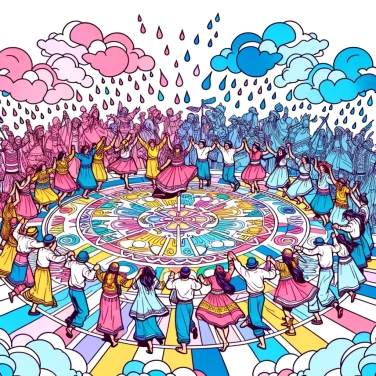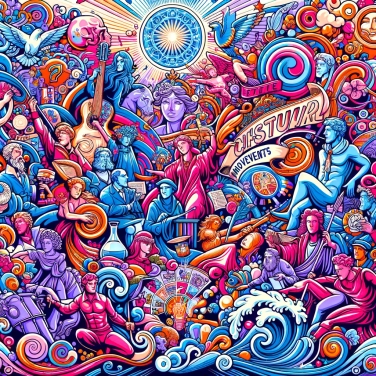The rain dance is a cultural practice in some societies as it is often associated with rituals and beliefs that allow for the invocation of rain, a vital resource for agriculture and the survival of communities.

In many agricultural or rural communities, precipitation directly influences food and economic survival. The rain dance has logically emerged to try to attract rain during particularly dry or critical periods for crops. Over time, these societies have developed an empirical understanding of the natural cycles of rain and climate, closely linking their ritual to their immediate environment. When the rain is slow to come, threatening the harvests and water availability, the dance represents an attempt to influence or symbolically solicit natural forces to ensure the fertility of the soil, the sustainability of food resources, and the survival of the group. Even today, in some parts of the world, these dances persist as a direct cultural response to specific ecological challenges related to water and potential climate change.
Many societies associate the rain dance with a powerful connection to spirits or higher forces governing nature. Drought then sometimes represents anger, indifference, or simply an emotional distance between humans and these supernatural entities. Through the dance, groups primarily seek to restore a form of spiritual harmony, renew the lost balance, or even ask for forgiveness for mistakes made. The gestures, symbols, songs, and costumes during these rituals are highly codified, with precise meanings depending on the cultures. Each symbolic element serves to strengthen the participants' connection to the divine or to ancestors, through a strong collective expression and direct communication with the invisible. The rain itself then becomes the concrete symbol of the listening and kindness of the addressed spirits.
Celebrating the rain dance strengthens the unity of the group, bringing the entire community together around a common goal. The event allows individuals to share the same emotional experience, a strong expression of their cultural identity. Participating together in these ceremonies solidifies familial and community bonds, and facilitates the integration of new members into the group. The songs, dances, and sometimes special outfits worn during these practices reinforce belonging to the group, emphasizing the collective history and shared values. Through this dance, the entire village or tribe comes together in a special moment, where everyone finds their place and strengthens their sense of solidarity.
The rain dance is traditionally taught to the young by their elders, often in the form of hands-on learning. Through this, children absorb the cultural values and beliefs specific to their community. It helps preserve a certain cultural identity and strengthens the sense of belonging within the group. Telling myths around the ceremonies, demonstrating the gestures, explaining symbols and songs: all of this ensures that the tradition survives from one generation to the next. As a result, even today, some communities continue to practice these rituals by adapting them to their daily lives while respecting the teachings of their ancestors.
Today, communities practicing the rain dance face two challenges: adapting to modern lifestyles while keeping their traditional practices alive. Some now integrate contemporary elements into the rituals, such as amplified music or modern clothing, without losing their deep meaning. There are even cultural festivals organized to raise awareness of these customs and promote their preservation among younger generations. Rather than disappearing, the practice is evolving by finding its place in today’s daily life while still strongly affirming a cultural identity.
The rain dance is not always a literal request for rain: for some peoples, it is also a spiritual symbol of the purification of souls or a general call for prosperity and abundance.
In Australia, some dances performed by Indigenous communities, often referred to as 'rain dances,' also have an educational dimension aimed at passing on traditional knowledge about the weather and nature to new generations.
Some ethnographic research shows that rain dance contributes to strengthening the psychological resilience of communities, enabling them to better collectively manage periods of drought or climate uncertainty.
Among the Hopis (Native Americans from the southwestern United States), the rain dance symbolizes not only a request for precipitation but also the harmony between humans, the earth, and natural elements.
From a strictly scientific point of view, there is no evidence confirming that rain dance can directly influence precipitation. However, this practice holds significant cultural, spiritual, and symbolic meaning for certain communities.
Even though the primary motivation is usually to invoke rain for agricultural crops or to combat drought, the rain dance often goes beyond that: it strengthens community cohesion, reminds us of the spiritual connections existing between human society and nature, and celebrates cultural identity.
No, each society has its own traditions and associated symbolism. Thus, movements, music, clothing, and even times of the year can vary greatly from one culture to another, reflecting the specific beliefs of each group.
Yes, in certain regions of the world, particularly in Africa, North America, Australia, and Asia, various communities continue to perform rain dances during traditional ceremonies and cultural events open to visitors, as long as local customs and traditions are respected.
Some traditional practices, such as the rain dance, are experiencing evolution or adaptation due to globalization and urbanization. However, various communities are currently making efforts to promote, pass on, and preserve these traditions for younger generations.

0% of respondents passed this quiz completely!
Question 1/5